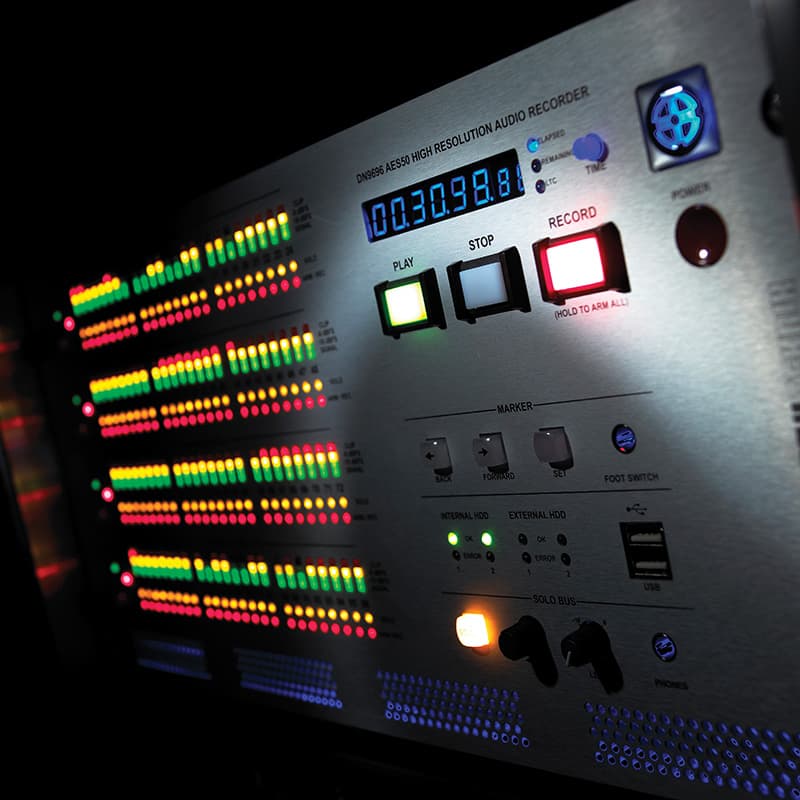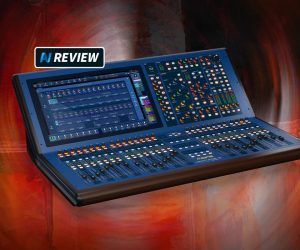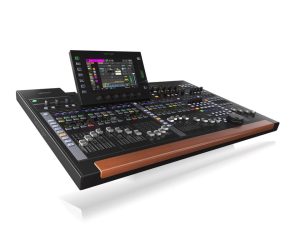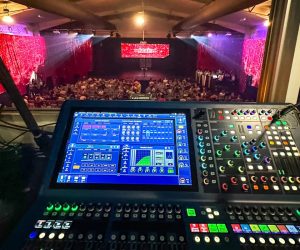
Midas Pro1
Small Format Digital Live Console.
Review:/ Guy Harrison
Midas has never been a company to rush things. Many considered its entrance into the digital console market to be tardy at best. But the 2006 release of the large-format XL8 ultimately proved to be a revelation. Demonstrating that Midas was not content to simply release a carbon copy of other digital consoles in the market at the time, but had listened to engineers and re-thought how to access a digital console more efficiently. Midas did more than just introduce new buttons, they brought colour to the workspace and a new approach to grouping and redundancy that continues throughout the Midas digital console product line today.
THE BABY ARRIVES
Smaller consoles inevitably followed the XL8 with the Midas Pro range delivering the Pro9, 6, 3, and 2 (not in order of debut), until eventually the baby of the family arrived – the Pro1.
Unlike its digital brethren, the Pro1 can act as a drop-in replacement for an analogue console. It backs 24 mic inputs along with 16 XLR bus outputs plus Left, Right, Mono, and Control Room A and B outputs. Internal processing allows for access to 40 inputs and eight return buses all of which have four-band parametric EQ and inserts. These additional input channels can be accessed utilising the rear AES 50 ports over Cat5 cable connected to one of Midas’s optional stage boxes. This makes for a great ‘buy-now/expand-later’ option. The display is daylight viewable and, according to Midas, for the same reason it’s also not a touchscreen – not entirely sure about that logic. But it does mean you can use the console without having to be under a canopy at an outdoor show, or shading the screen while trying to operate single-handedly. Instead of accessing a touchscreen, navigation is controlled by a trackball and various buttons.
To put the Pro1 through its paces I decided to put it to use on a music TV show The Music Café where I would be mixing live for a studio audience, multi-track recording the show and providing a mix for cameras. Oh yeah, there would also be three bands with varied line ups appearing on the day. It’s fair to say that it would be a routing challenge. Considering I’d only had limited time on Midas digital consoles I decided it prudent to do the Midas training course. An added advantage of doing the training course was having the very helpful Midas rep on hand to help me build my show file.
MORE INFO
PRICE
$13,750
$14,250 (with roadcase)
CONTACT
National Audio Systems: 1800 441 440 or [email protected]

STARTING FROM SCRATCH
Out of the box, the Pro1’s I/O is going nowhere – the first job is to organise your routing. This is a point of difference over most other small format digital consoles but it does allow for great flexibility when connected to one or more of the Midas stage boxes. Thankfully Midas has made the routing a fairly quick process with some clever modes that allow you to do things like route consecutive inputs to buses with a few button presses. As we were multi-track recording the show, the local inputs on the rear of the Pro1 were to be routed to the stereo bus, and we would be connecting the AES50 ports to the Midas-recommended Klark Teknik DN9696 recorder that CPC Production Services graciously supplied for the gig (thanks CPC).
Next step is to choose how you will allocate your DSP processing between effects and graphic EQs. There is plenty of processing available on the Pro1. You can choose combinations between six effects and eight graphic EQs, through to one effect and 28 graphic EQs. As I would be providing six sends of foldback I went with the first combination, using a graphic EQ for each of my six foldback sends, leaving two spare for FOH duties. After routing Buses 1-6 to the physical XLR outputs on the rear of the Pro1, I then assigned the Graphic EQs to those buses, set them to pre-fade and was done.
At first I must admit I found starting from scratch with the routing on the Pro1 a bit of a chore, and thought to myself, ‘What’s the point?’ But then I got to thinking, there’s a lot packed into this small console. It’s not just a one-trick pony that would warrant being pre-set. The Pro1 can access up to 100 inputs, 102 outputs, and process 40 input channels and eight returns with full EQ and dynamics processing, as well as provide mixes to 27 buses.
But how could you possibly control those 40 inputs effectively on the 16 faders supplied on the Pro1? Well, Midas has given that some thought too. While most digital desks use a layers system to get at all the input channels, Midas has a different approach. The faders on the Pro1 are split into two groups of eight with the left-most fader group designed to be used for channels, and the right, VCA groups. Page buttons are provided beside the left fader group to allow you to access the channels beyond the first eight. Also an Extend button will make the right VCA faders into channel faders if this is your preference. Holding down a VCA Group on the right and selecting channels from the left fader group assigns them to that VCA master, which you can separate be name and colour.
In my case, the most complex band I worked on was a five-piece pop/rock outfit, so as well as having the usual VCA groups of Guitars, Keys, Vocals, etc, I also set up an effects return on a VCA too. Nothing groundbreaking so far, but here’s the twist; now that I’d assigned all the channels to VCAs, when I selected any VCA it brought only its channel members to the left fader group. So when I selected the Vocal VCA group, my left bank of eight faders only show my six radio mics on inputs 19-24 and all a pretty blue – genius! This is a far cleverer way to access channels than searching down through the main channel faders to find them. And if that’s not enough there are six POP (Population) groups available, which are similar to a VCA’s grouping, just without a fader. Pressing any of the 16 bus buttons brings them to the faders and a similar function called Collapsed Flip is available so only channels contributing to the selected bus appear on the left faders. There are also eight rotary encoders and eight buttons above the left fader bank which vary in use depending on where you are on the screen. These can also be custom programmed to be whatever you like when in the home screen.
The Midas mic preamps carry a lot of hype. It’s the oldest trick in the book for Midas engineers to run the mic pres hot to really hoe into their pleasing saturation. But on a typical digital console it’s not easy to push the mic pre into saturation as gain structures will generally digitally clip the input before the mic pre saturates – they are in effect hard wired and factory set. Midas gets around this limitation by providing both analogue and digital gain stages. These are available on the same knob with a ‘swap’ button to switch between them. You can wind up the analogue gain for some pleasant harmonic saturation, and then use the digital trim to set your gain structure. Ah, makes me forget I’m on a digital console!
KLARK TEKNIK DN9696 RECORDER
The Klark Teknik DN9696 is a standalone recording system and as the name would suggest is capable of a massive 96 channels at 24-bit/96k. It’s designed for use with Midas consoles so uses the AES50 protocol. It comes equipped with two internal drives for up to nine hours of recording and is controlled by a combination of mouse, keyboard and front panel controls.
Klark Teknik’s design brief was to create a simple to use standalone recorder that could withstand the rigours of touring. Standing at 5U high it imposes a hefty footprint. Front panel space is mostly dominated by four rows of 24 LED ladders for metering. Large backlit transport controls for Stop, Record and Play, plus locate marker controls and some monitoring options round out the front panel. At the rear there is the AES 50 I/O plus all the connections you would expect to find on a computer including Firewire and E-sata drives.
The Klark Teknik GUI is simplicity itself. Everything is very cleanly presented and visible from the one screen. Channels are viewable in banks of 24 that can be switched via the mouse or front panel buttons situated beside the LED ladder rows. Some Midas thinking is visible on the GUI too, with POP groups and colouring available. In operation, the KT9696 was flawless and rock solid.
Files are recorded as broadcast wav and all in one folder for easy transport to an external drive. With
my measly 24 tracks it didn’t even bother to write to its second internal drive! This would be an ideal device for virtual sound checking. In fact at the end of the Music Café TV recording I ticked two preference boxes on the Midas Pro1, pressed play on the KT9696, and played the last band’s set back through the Pro1 processing. Very cool indeed!
Price: $18,999

DYNAMIC IN THE DETAIL
As you would expect, the Pro1 is feature laden but it’s the small details that make all the difference. EQ-wise – high- and low-pass filters are available with switchable slopes plus a four-band parametric EQ with a choice of four different filter types for the high and low bands. Some of these EQ shapes are derived from past Midas analogue consoles in case you’re feeling nostalgic. The dynamics section is equal to any task with four different styles of compression available. Gating is as you would expect. All sections contain a button that when pressed brings it to the screen, with well thought out visual representations, the gate graphic in particular makes setting it a doddle. Copy
and paste is also well implemented, taking in whatever is currently on screen. If you want to copy one vocal EQ to another channel, press the button in the EQ section to bring it to the screen, press Copy, select the channel you want to paste it to and hit Paste. Being in the channel overview screen means all settings can be copied. ‘Group’ and ‘All’ are available options for pasting to multiple channels.
The effects on the Pro1 are also outstanding. The Midas and Klark Teknik link is apparent with a few KT classics featured, such as the DN780 multi-effects unit and the more recent SQ1 dynamics processor. There are also the usual suspects from delays and choruses, to pitch shifters, reverbs and multi-band compressors. And the version two software update adds even more. All effects can be used ‘send and return’ style or inserted on channels.
LITTLE GUY, BIG SOUND
Which brings me to the sound. Quite simply, brilliant! You will be hard pressed to find a better sounding console at any price point. Everything about this console oozes quality. From the moment you pull your first kick drum sound everything just feels right. Sure it’s a digital console and there is a learning curve but with your hands on the controls it feels very analogue. As you sweep a parametric EQ the image is rock-solid stable. It never sounds like something is stepped or shifting – no matter what you do. This is in part due to Midas’s internal processing and delay compensation management that keeps everything travelling through the console sample and phase accurate.
I will admit to being a little apprehensive about doing such a high pressure gig on so few faders but the way the Pro1 VCAs function makes navigation easy. After working this way I wished all digital consoles did. My only minor gripe? When I reach for a compressor I would prefer the default setting not to be infinity to 1! And whilst I’m at it, the EQ default Q of 0.27 is a little sharp for me. Of course if I owned the console I would just change these defaults to what ever I wanted and save a new show file. That’s part of the beauty of the Pro1 too. It’s incredibly versatile. It’s crazy to think this little rack-mountable mixer can be a 27-send monitor console. If you’re in the market for a high-end console and are not scared by a small footprint, the Pro1 is a no brainer – two thumbs up!














RESPONSES